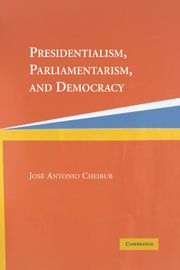Book contents
- Frontmatter
- Contents
- List of Figures and Tables
- Acknowledgments
- 1 INTRODUCTION
- 2 PRESIDENTIAL, PARLIAMENTARY, AND MIXED DEMOCRACIES
- 3 ARE THE INCENTIVES FOR COALITION FORMATION DIFFERENT IN PARLIAMENTARY AND PRESIDENTIAL DEMOCRACIES?
- 4 ARE COALITIONS RARE IN PRESIDENTIAL DEMOCRACIES?
- 5 PARTY DISCIPLINE AND FORM OF GOVERNMENT
- 6 WHAT MAKES PRESIDENTIAL DEMOCRACIES FRAGILE?
- 7 CONCLUSION
- Appendix: Definition and Sources of Variables
- References
- Index
- Cambridge Studies in Comparative Politics
2 - PRESIDENTIAL, PARLIAMENTARY, AND MIXED DEMOCRACIES
Published online by Cambridge University Press: 05 June 2012
- Frontmatter
- Contents
- List of Figures and Tables
- Acknowledgments
- 1 INTRODUCTION
- 2 PRESIDENTIAL, PARLIAMENTARY, AND MIXED DEMOCRACIES
- 3 ARE THE INCENTIVES FOR COALITION FORMATION DIFFERENT IN PARLIAMENTARY AND PRESIDENTIAL DEMOCRACIES?
- 4 ARE COALITIONS RARE IN PRESIDENTIAL DEMOCRACIES?
- 5 PARTY DISCIPLINE AND FORM OF GOVERNMENT
- 6 WHAT MAKES PRESIDENTIAL DEMOCRACIES FRAGILE?
- 7 CONCLUSION
- Appendix: Definition and Sources of Variables
- References
- Index
- Cambridge Studies in Comparative Politics
Summary
The concern with presidential democracies stems from the constitutional separation between the executive and the legislative assembly: the government, headed by the president, does not require any legislative support in order to exist. From this fact are supposed to follow, as I demonstrated in the previous chapter, a number of consequences that may eventually lead to the death of the democratic regime.
The first step in evaluating the empirical validity of this view is to identify the set of democracies that should be at risk. This requires that we first identify the set of countries that are democratic and then the democratic regimes that have a system in which the government and the assembly are independent from one another. Therefore, in this chapter I start by presenting the rules for classifying political regimes into democracies and dictatorships. I then review the criteria underlying existing classifications of democratic forms of government and provide an alternative that focuses exclusively on the relationship between the government and the legislative assembly. Following the existing literature, I distinguish three types of regimes: pure presidential democracies, pure parliamentary democracies, and mixed systems.
Democracies and Dictatorships
Since the concern of this book is with the survival of democracies, the first order of business is to separate democracies from dictatorships. Here I use the classification of political regimes first proposed in Alvarez et al. (1996) and updated in Przeworski et al. (2000).
- Type
- Chapter
- Information
- Presidentialism, Parliamentarism, and Democracy , pp. 26 - 48Publisher: Cambridge University PressPrint publication year: 2006

